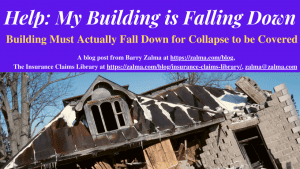Help: My Building is Falling Down

See the full video at https://rumble.com/v20st5s-help-my-building-is-falling-down.html and at https://youtu.be/1EN3cXOZVZY
Windcrest Owners Association filed a lawsuit against Allstate Insurance after the company declined a claim for property damage to a building in its condominium development. Allstate moved for summary judgment, alleging that the property damage was not covered as a “collapse” and was excluded from coverage because it resulted from faulty construction and maintenance. The trial court granted summary judgment dismissing Windcrest’s claims.
In Windcrest Owners Association, a Washington nonprofit corporation v. Allstate Insurance Company, an Illinois company, State Farm Fire And Casualty Company, an Illinois company, No. 82836-3-I, Court of Appeals of Washington, Division 1 (December 12, 2022) Windcrest sought payment to repair a building in severe distress as a result of wear, tear, and defective construction under a “collapse” coverage. The Court of Appeals read the full policy and applied its language to the facts presented by construction experts.
FACTS
Windcrest Condominiums, which consists of 15 units in two buildings, was completed in 1995. Allstate provided a commercial property insurance policy from November 2002 through 2017.
In October 2018, Windcrest notified Allstate of a property damage claim based on a structural report prepared by Dibble Engineers. The report noted decay consistent with substantial impairment of structural integrity to one of the buildings. Specifically, it noted, “The capacity of the building’s lateral- and gravity-force-resisting systems are compromised by decay that has been hidden by the exterior siding.”
Allstate, conducting a good faith investigation of the claim, retained construction consultants from Madsen, Kneppers & Associates, Inc. (MKA) to conduct an inspection and evaluation of causation of the damage at Windcrest. MKA concluded that there were sites of noted decay of structural components but no evidence of collapse “defined as an abrupt falling down or caving in,” as required for coverage by Allstate’s policy.
Windcrest sued Allstate, alleging breach of contract and bad faith. Allstate moved for summary judgment; the trial court granted the motion and dismissed the claims with prejudice.
ANALYSIS
Determining whether coverage exists is a 2-step process.
The insured must show the loss falls within the scope of the policy’s insured losses.
To avoid coverage, the insurer must then show the loss is excluded by specific policy language.
An insured has the burden of proving that coverage is triggered, while the insurer has the burden of proving that an exclusion applies.
Collapse Coverage
Windcrest made a claim under the Allstate insurance policy. The coverage provided under an Additional Coverage Collapse applies only to an abrupt collapse as described and limited.
The Allstate policy defines “collapse” as follows: “With respect to buildings: a. Collapse means an abrupt falling down or caving in of a building, or any part of a building, with the result that the building or part of a building cannot be occupied for its intended purpose; b. A building or any part of a building that is in danger of falling down or caving in is not considered to be in a state of collapse.”
In addition to the lack of suddenness, Windcrest failed to provide evidence that the building or parts of the building fell down, fell to pieces, or caved in. Rather it still stood and was occupied. In addition the MKA study noted that there was damage to the buildings and that “there is no evidence to indicate that any parts of the building are currently . . . in a state of collapse as defined as an abrupt falling down or caving in.” Indeed, a Windcrest resident and board member confirmed that no part of the building had caved in or abruptly fallen down.
Windcrest produced no evidence that the structures were no longer habitable. A Windcrest resident and board member confirmed that Dibble never informed the board that the buildings were unsafe or unfit to occupy. The Court of Appeal concluded that the Windcrest buildings have not collapsed such that they can no longer be occupied for their intended purpose. In addition, the Court of Appeal noted that Windcrest had not demonstrated a collapse as defined by the Allstate insurance policy and that the collapse coverage does not apply.
The evidence from both Allstate and Windcrest demonstrated that defective construction and maintenance initiated the chain of causation resulting in the loss. Allstate submitted both a report and deposition testimony from expert David VanDerostyne to support a coverage exclusion due to defective construction. The report stated conclusively that decay and deterioration occurred over an extended number of years due to “defective original construction in combination with lack of repairs and/or maintenance” in addition to a lack of a collapse.
Since the evidence showed no abrupt or sudden falling down of any part of a building such that it could not be occupied for its intended purpose. As a result the policy coverage for collapse did not apply. Based on the evidence properly before the trial court, the damage to the condominium originated with faulty construction and maintenance.
The Allstate policy explicitly excluded coverage for faulty construction and maintenance, as well as for any loss initiated by those excluded perils. Therefore, the Court of Appeal concluded that the trial court properly granted summary judgment for Allstate and dismissed Windcrest’s claims.
Allstate provided coverage to insured’s whose property collapses. However, it provided a clear and unambiguous definition of the word “collapse.” Although Windcrest’s expert used a technical definition of “collapse” that fit engineering practices it did not fit the definition of “collapse” in the Allstate policy. Once a contract is written an accepted by an insured the wording cannot be changed by a court to provide the coverage the insured would like and must apply the coverage written in the policy.
(c) 2022 Barry Zalma & ClaimSchool, Inc.
 Subscribe and receive videos limited to subscribers of Excellence in Claims Handling at locals.com https://zalmaoninsurance.locals.com/subscribe.
Subscribe and receive videos limited to subscribers of Excellence in Claims Handling at locals.com https://zalmaoninsurance.locals.com/subscribe.
Go to substack at substack.com/refer/barryzalma Consider subscribing to my publications at substack at substack.com/refer/barryzalma
Barry Zalma, Esq., CFE, now limits his practice to service as an insurance consultant specializing in insurance coverage, insurance claims handling, insurance bad faith and insurance fraud almost equally for insurers and policyholders. He practiced law in California for more than 44 years as an insurance coverage and claims handling lawyer and more than 54 years in the insurance business. He is available at http://www.zalma.com and zalma@zalma.com
Write to Mr. Zalma at zalma@zalma.com; http://www.zalma.com; http://zalma.com/blog; daily articles are published at https://zalma.substack.com.
Like this:
Loading…




